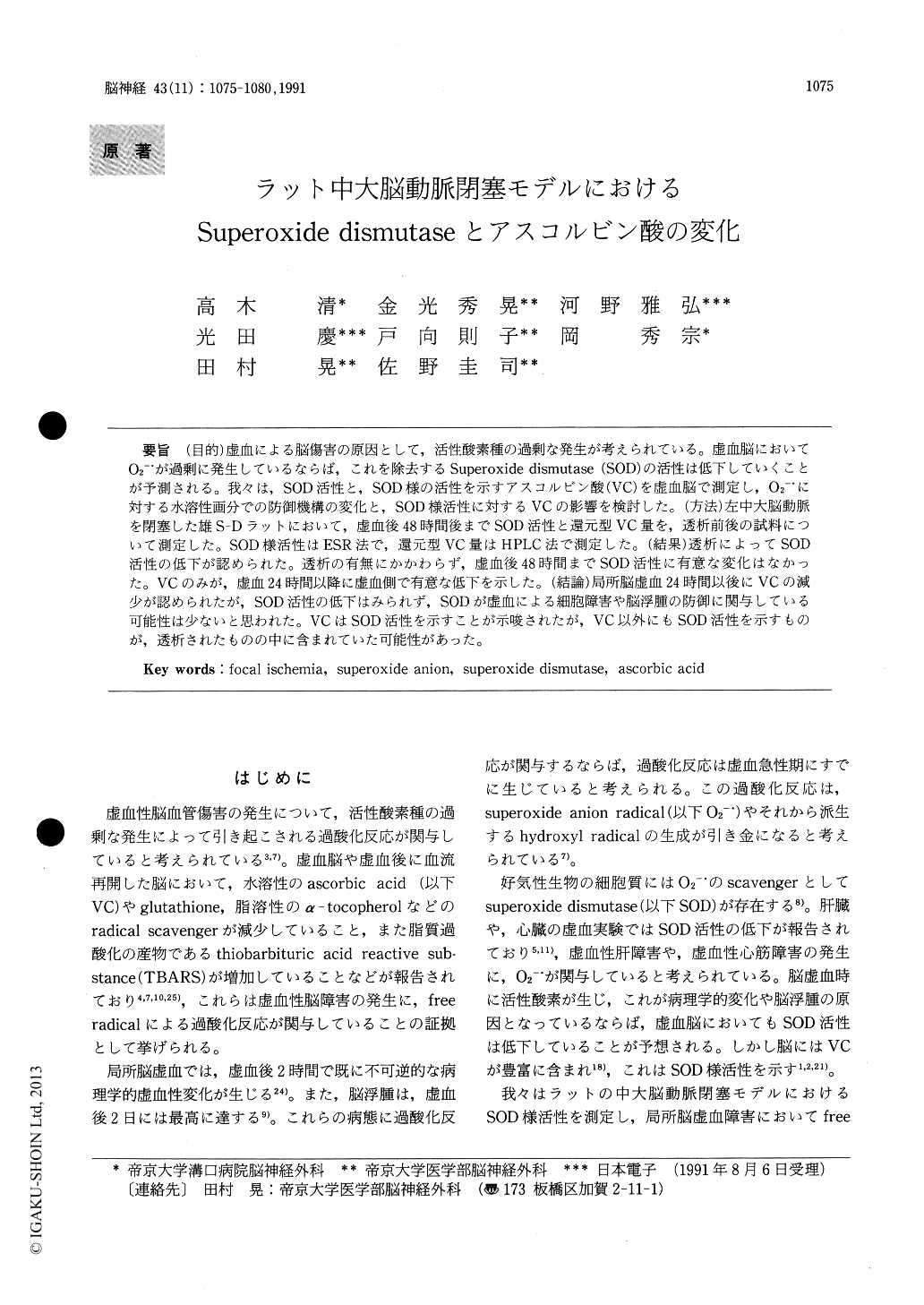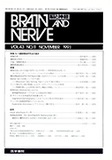Japanese
English
- 有料閲覧
- Abstract 文献概要
- 1ページ目 Look Inside
(目的)虚血による脳傷害の原因として,活性酸素種の過剰な発生が考えられている。虚血脳においてO2−・が過剰に発生しているならば,これを除去するSuperoxide dismutase(SOD)の活性は低下していくことが予測される。我々は,SOD活性と,SOD様の活性を示すアスコルビン酸(VC)を虚血脳で測定し,O2−・に対する水溶性画分での防御機構の変化と,SOD様活性に対するVCの影響を検討した。(方法)左中大脳動脈を閉塞した雄S-Dラットにおいて,虚血後48時間後までSOD活性と還元型VC量を,透析前後の試料について測定した。SOD様活性はESR法で,還元型VC量はHPLC法で測定した。(結果)透析によってSOD活性の低下が認められた。透析の有無にかかわらず,虚血後48時間までSOD活性に有意な変化はなかった。VCのみが,虚血24時間以降に虚血側で有意な低下を示した。(結論)局所脳虚血24時間以後にVCの減少が認められたが,SOD活性の低下はみられず,SODが虚血による細胞障害や脳浮腫の防御に関与している可能性は少ないと思われた。VCはSOD活性を示すことが示唆されたが,VC以外にもSOD活性を示すものが,透析されたものの中に含まれていた可能性があった。
It has been proposed that free radical reactions are involved in ischemic brain damage. Since ir-reversible pathological changes occurs very early phase of the focal ischemia and the ischemic brain edema reaches its peak at about 2 days of ischemia, the free radical reactions must take place beforethese changes. Superoxide dismutase is a famous enzyme that dismutase superoxide anion, which is believed to be one of the initiator of the free radical reactions. If superoxide anion plays a pivotal role in the genesis of pathological ischemic brain damage and edema, the activity of the enzyme may decrease in the early phase of ischemia. Ascorbic acid is also known to be a scavenger of superoxide anion, and brain tissue contains it in a high concentration.
We investigated the changes in superoxide dis-mutase activity and concentration of reduced ascor-bate in focal ischemia. Focal ischemia was produced in rats by permanent occlusion of the left middle cerebral artery. The animals were decapitated 30 minutes, 4, 24, and 48 hours after the operation. Middle cerebral artery territory of each cerebral hemisphere was homogenized and centrifuged with phosphate buffer. The supernatant was divided into two aliquots ; one was dialyzed to remove ascor-bate and the other was not. The SOD activity was measured by electron-spin-resonance (ESR) spin trapping method, and the ascorbic acid concentra-tion was measured by high performance liquid chromatography with electrochemical detection (HPLC-ECD) . Protein concentration was measured by Lowry's method. The enzyme activity was ex-pressed as unit/mg protein, and the ascorbic acid concentration was expressed as μg/g tissue.
The SOD activity decreased markedly by dialysis. The enzyme activity of the dialyzed speciment from the left hemisphrer was 7.8 ±1.0 (unit/mg protein, Mean± S. E. M.) in control rats. It did not change significantly up to 48 hours after the arterial occlu-sion. The SOD activity of the dialyzed specimen from the non-ischemic, right hemisphere was 9.1 ±0. 8 (unit/mg protein), and unchanged during the examination. Reduced ascorbic acid levels became negligible by dialysis. In the non-dialyzed control specimens, the VC contents were 455.3±30.3 mg/ gram tissue for the right side and 430.3 ±44.7mg/ gram tissue for the left side. The VC levels of the non-dialyzed samples from the non-ischemic, right side of the animals with arterial occlusion were almost constant throughout the 48 hours period. In contrast, the VC levels of the non-dialyzed samples from the ischemic, left side decreased significantly at 24 hours and 48 hours after MCA occlution.
Our data suggest that the SOD did not decrease significantly up to 48 hours after the onset of focal ischemia. We also show that dializable low molecu-lar substances other than ascorbic acid possibly have SOD-mimic activity, even though ascorbic acid may exert the SOD activity.

Copyright © 1991, Igaku-Shoin Ltd. All rights reserved.


